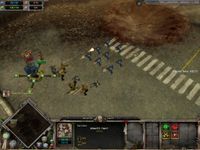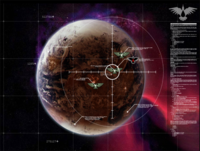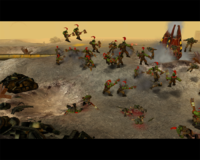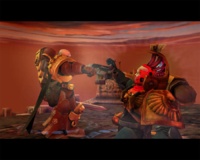Warhammer 40,000: Dawn of War
From Wikipedia, the free encyclopedia
| Blood Ravens is a candidate to be copied to the Warhammer 40k Wiki using the Transwiki process established by the Warhammer 40,000 Wikiproject. In preparation for transwiki, Blood Ravens needs to be upmerged into this article. |
| Warhammer 40,000: Dawn of War | |
|---|---|
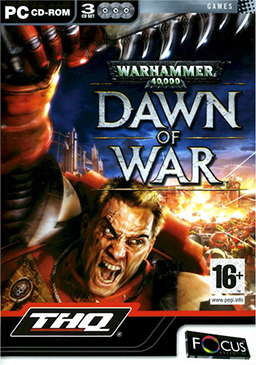 |
|
| Developer(s) | Relic Entertainment |
| Publisher(s) | THQ |
| Engine | IC+ |
| Version | 1.51 |
| Platform(s) | Microsoft Windows |
| Release date | NASeptember 20, 2004[1] EURSeptember 24, 2004[2] |
| Genre(s) | Real-time strategy |
| Mode(s) | Single player, multiplayer |
| Rating(s) | ESRB: Mature (M) PEGI: 16+ USK: 16+ |
| Media | 3 CD-ROMs, Steam download |
| System requirements | 1 GHz Pentium III or equivalent AMD Athlon XP processor, 256 MB RAM, 1.8 GB free hard drive space, 4x CD-ROM, 32 MB DirectX(R) 9.0b compatible AGP video card with Hardware Transform and Lighting, DirectX 9.0b compatible 16-bit sound card |
| Input method(s) | Keyboard, Mouse |
Warhammer 40,000: Dawn of War is a real-time strategy computer game developed by Relic Entertainment based on Games Workshop's popular tabletop wargame, Warhammer 40,000. It was released by THQ on September 20, 2004 in North America. Since its release, two expansion packs have been released: Winter Assault in 2005 and Dark Crusade in 2006. A third expansion, Soulstorm, is currently being produced.[3]
The Game of the Year edition was released on September 20, 2005 in the USA and on September 23 in Europe, containing 4 exclusive maps. Later, the Game of the Year edition and Winter Assault were bundled in the Gold Edition in the USA. Most recently, Dawn of War and both of its expansions were released together as The Platinum Collection in the USA or as the Dawn of War Anthology in the PAL regions.
Contents |
[edit] Gameplay
Gameplay is initially focused on base and unit construction. The player starts with a single HQ building and a few basic units, usually just one building unit. Subsequent focus then shifts to capturing and holding strategic locations on the battlefield. These control points are captured by infantry squads and provide resources to construct additional units and buildings or unlock certain units in an army's tech tree. Battles are won either by holding a certain number of control points for a period of time or by destroying all of the opposing armies' HQ structures.
[edit] Resource management
Two primary resources exist: requisition and power. These resources are not harvested or otherwise gathered by the player's units. Instead, requisition is generated constantly by the army headquarters. The player can increase the rate at which requisition is acquired by using infantry squads to capture and control certain "strategic points" on the battlefield. These points can be reinforced with defensive structures that also increase the rate of requisition accumulation. Though resources are unlimited, all sources of requisition will eventually decay, dramatically decreasing their supply rate.
Power is gathered by building generators, with each headquarters supporting up to six generators. Additionally, some maps have "slag deposits", upon which more powerful generators can be constructed to produce power faster. As the player progresses up the tech tree, reliance on power increases.
In addition to these primary resources, the Orks also have Ork resource. Ork resource is generated continuously by Waaagh! banners and is used up when creating Ork troops and vehicles. The number of banners and the size of the Ork population determines the Ork's Waaagh! level which in turn determines the technology level the player has access to.
[edit] Warfare
Infantry units are given orders as squads rather than as individuals. Most fully reinforced squads consist of about 10 units. The squad moves and attacks as a single entity. Squads can produce and replace their own units anywhere in the field. They can be equipped with special weapons and have heroes or special units attached to them. For example, a Space Marine squad starts with 4 marines, but can be expanded up to 8 standard marines and a sergeant, and individual marines can be equipped with heavy weapons. The player is also free to choose particular upgrades and can specialize each squad for a specific purpose.
Infantry units can fight in both ranged and hand-to-hand combat, and most units will have weapons for both types of combat, and if attacked in close combat will respond in kind. Hand-to-hand combat is played out as a series of attack animations between combatants. When one combatant kills the other, a Finishing move commonly called a Synch Kill plays out as the victorious fighter finishes his opponent off. More powerful units, such as Heroes, Walkers, and monstrous Super Units, may have personalized Synch Kills against each other.
Vehicles are highly resistant to standard infantry rifles, so they must be targeted with specific weaponry (e.g. rockets) to be destroyed. Vehicles can also be upgraded with multiple weapon systems, usually differentiating between anti-infantry and anti-vehicle armaments. Walkers are a variant type of vehicle that is capable of fighting in close combat
In addition to a typical hitpoint system, infantry units also have morale. Morale applies to a squad as a whole. When morale drops to zero, the squad "breaks;" at this point the squad's accuracy at a range, damage dealt in mêlée, and defensive capability while using cover are significantly reduced, however the squads movement speed is slightly increased. The squad's morale will regenerate on its own while the squad is not in combat. Some weapon types, such as flamethrowers, are made specifically to demoralize the enemy. Favorable terrain gives units a defensive cover bonus, while water and swamps slow units down and decrease their defensive ability.
[edit] Setting
The game is set in the Warhammer 40,000 universe, a dystopian vision of the future with gothic undertones. Humanity has forged a galaxy-spanning empire, The Imperium, with the Immortal Emperor as humanity's leader and God. The Imperium is in a state of constant war with the Orks, Eldar, and the human servants of Chaos. The single player campaign is set on the planet Tartarus.
[edit] Factions
Warhammer 40,000: Dawn of War features four playable armies.
The Space Marines are the elite genetically modified superhuman soldiers of the Imperium. Space Marines have the highest morale in the game. Their troops and vehicles are more expensive, however. The Space Marines are the only playable race in the single player section of the game, and the 11-mission campaign features the Blood Ravens chapter as the protagonists, led by Captain Gabriel Angelos and Librarian Isador Akios.
The Chaos Marines are traitors that have chosen to abandon The Imperium and their duties to humanity, and instead worship the Gods of Chaos. In Dawn of War, they use troops that are similar to their Imperium counterparts. In addition, they employ morale-draining daemons and psykers. The campaign features the Alpha Legion, with their leaders, Sindri Myr and Lord Bale.
The Eldar are an ancient, technologically advanced race. Eldar in Dawn of War are fast and fragile. They are able to move quickly across the map via webway gates. The campaign features the craftworld of Biel-Tan, and their leader, Farseer Macha.
The Orks are a savage, warlike race. In large enough numbers, they gain morale immunity. The tech tree for Orks differs from the other races in that it depends on the amount of orks currently in your army and the number of erected WAAAGH!! banners. Several clans are featured in the campaign, as is the Ork Warboss, Orkamungus.
In addition to the four fully playable races, the Imperial Guard also make appearances in the single player campaign as allies of the Space Marines, led by Colonel Brom. They would later be made into a featured race for the first expansion pack, Warhammer 40,000: Dawn of War: Winter Assault.
[edit] Plot
- See also: List of Warhammer 40,000: Dawn of War characters
- See also: List of units in the Warhammer 40,000: Dawn of War series
The Single player campaign is set on the planet Tartarus, an Imperial planet that is currently being besieged by a large Ork Waaagh!! The campaign begins with Colonel Brom and his 37th Tartarus Planetary Defense Force Regiment under attack by a large group of Orks. The Blood Ravens 3rd company, led by Captain Angelos makes planet fall and saves Brom and his remaining men and then proceed to exterminate the remaining Orks in the vicinity. In the aftermath of the battle, Gabriel is joined by the Librarian Isador Akios. Brom asks Isador about a recently conducted Exterminatus of the planet Cyrene, however Isador makes it clear he is not to bring it up again. The Blood Ravens then prepare for a mission of extermination of the Orks surrounding the port, in order to protect the evacuation craft.
Isador, sensing that the Captain's mind is troubled, realises why, and tells him that there was nothing he could have done to save his home planet of Cyrene. However, Gabriel tells him not to mention it again, stating that his homeworld was his responsibility. After the extermination of the Orks, scouts reveal to Gabriel that Chaos are operating on the planet. Soon after this they are joined by an Inquisitor, Toth, who orders them to leave the planet, warning that a Warp Storm is approaching the planet and will consume the planet in 3 days time. Toth orders a complete evacuation of the planet. On further investigation, it is revealed that the Eldar are also operating on the planet. The Blood Ravens find an altar dedicated to Chaos, confirming Gabriel's suspicions, and resolves to destroy the traitors, unknowing that Isador is already under the influence of blackheart, the Chaos Sorcerer of the Alpha Legion.
Upon destruction of most of the remaining Eldar by Gabriel's forces, the Farseer pleads with Gabriel to heed her words; however during their moment of distraction, Sindri steals an artifact, which Macha reveals to be a key to "the undoing of this world". Upon inquiry, the Farseer shows surprise at their ignorance, commenting that the Inquisitor 'keeps them on a short leash' and implying that he knows more than he is telling, and advises them to ask him, before telling the Blood Ravens where to find the entrenched Chaos forces. Gabriel and Isador confront Toth in the ruins of an Imperial Temple, following a pitched battle with Alpha Legion forces, who reveals that the world is cursed, and bears an artifact of chaos: the Maledictum, a stone that contains the essence of a daemon. The forces of Chaos now bear all that they need to unearth it. Toth also explains that the Eldar were fighting to protect the stone, as it was they who imprisoned the daemon in the stone originally: as he puts it 'as Chaos's oldest enemy, the Eldar see themselves as the only capable defence against its influence. And we have paid for their arrogance'. Toth also says that the power of the Maledictum is enough 'to turn the faithful and drive men mad', having already corrupted much of the population of Tartarus and the Imperial Guard, as well as affecting the Blood Ravens somewhat. Gabriel and Toth form an alliance and make plans to find and destroy the Maledictum, however, Isador is then completely overcome by the temptations of Sindri and chaos, and resolves to steal the Maledictum for himself.
The Blood Ravens destroy the army of Lord Bale, who was betrayed by Sindri, during which time Isador seizes his chance and steals the Maledictum. In the face of Isador's betrayal, Gabriel pursues him in an effort to bring him to justice. The Blood Raven forces are successful in destroying Isador’s troops and Gabriel defeats Isador in single combat. Isador pleads for forgiveness to Gabriel. Gabriel tells him, "If redemption is what you seek, then redemption is what you shall get," before shooting him in the head with his bolt pistol, using him as an example to his men about the dangers of Chaos. Inquisitor Toth then reveals that he had known that chaos was corrupting one of the Space Marine commanders, but he had suspected Gabriel and they had paid the price for his error.
Meanwhile Sindri has used the power of the Maledictum to turn himself into a Daemon Prince. Inquisitor Toth bequeaths the Daemon Hammer God-Splitter to Gabriel. They then, with the Blood Ravens and the aid of the remaining Eldar forces of Farseer Macha, attack the Chaos forces, eventually killing the daemon prince Sindri. The final scene sees the Eldar and Blood Ravens standing around the Maledictum. Despite the warnings of Farseer Macha, who begs them not to destroy the stone, Gabriel obeys Inquisitor Toth and his own judgement, and destroys the Maledictum with God-Splitter. The Eldar forces then retreat, Macha warning prophetically Gabriel has doomed them all, and the Blood Ravens leave to be evacuated. However, Gabriel stays back, and encounters the Daemon of Khorne which he unwittingly released from the Maledictum. The daemon lets Gabriel and his men leave safely as thanks for its release, but tells Gabriel that he will soon come to claim him and his men. Gabriel vows to destroy the daemon, before following after his departing men.
[edit] Reception
| Publication | Score |
|---|---|
|
|
|
|
|
|
|
|
|
|
|
|
|
|
|
|
|
|
|
|
|
| Compilations of multiple reviews | |
|
|
|
|
|
|
Upon release, the critical response to Warhammer 40,000: Dawn of War was on the whole extremely positive. It was congratulated most frequently for its varied and balanced factions and units, its polished presentation, in particular the high quality of unit animations, and the user interface.
One of the first reviews was by IGN, who awarded the game 8.8/10, in particular praising the large level of graphical and animation detail.[11] They also cited the skirmish and multiplayer as one of the game's strongest points.[5] Gamespot came to similar conclusions, in particular praising the game's presentation and audio.[8]
Conversely, an area of the game that drew criticism was the single player campaign, which many reviewers found to be too short and unchallenging.[12][13] Another area of weakness identified was a lack of originality in the gameplay. However, these weaknesses were considered to be minor, IGN summarising "Nothing about the gameplay will really surprise anyone (though the addition of reinforceable squads is pretty neat) but it doesn't particularly matter...Relic kicked ass creating a great piece of entertainment."[5] The French website Jeux PC (lit. "PC Games") awarded the game 16 out of 20, in particular praising the simplicity of the user interface and the intensity of the battles.[14] German reviewer Daniel Matschijewsky awarded the game 83 out of 100, in particular praising the user interface and the sound, but identified the campaign and the AI as weaker areas.[15]
Overall Dawn of War was well received by critics, earning aggregate scores of 86/100 from Metacritic[10] and 87/100 from Game Rankings[4].
[edit] Awards
- Gamespy: 7th Best PC Game of 2004, Best Use of License 2004, 7th Best PC Game of 2006(Dark Crusade), Best Expansion of 2006(Dark Crusade)
- IC-Games: Editor's Choice Award
- IGN: Runner-up in Best Strategy Game of 2004, Runner-up in Best Multiplayer Game of 2004, Best Expansion Pack of 2005(Winter Assault), Best Expansion Pack of 2006(Dark Crusade)
- Tom's Hardware: Must Have award for December 2004
- Gamespot: Best Expansion Pack of 2006 (Dark Crusade)
According to the game box, the "Game of the Year" edition is based on the awards from GameSpy and Computer Gaming World. However, it only won a Top 10 (7th place) award from GameSpy[16] and "Best Real-time Strategy" Game of the Year from CGW.[17] Dawn of War did not win any overall GOTY awards from any major publication.
[edit] References
- ^ PC release dates. GameSpot. Retrieved on 2007-10-17.
- ^ Release dates. GameFAQs. Retrieved on 2007-10-17.
- ^ 1Up.com's preview of the October 2007 issue of Games For Windows. URL retrieved 18th of September 2007.
- ^ a b c d Warhammer 40,000: Dawn of War Reviews. Game Rankings. Retrieved on 2007-10-17.
- ^ a b c IGN: Warhammer 40,000: Dawn of War Review. IGN. Retrieved on 2007-10-17.
- ^ Biessener, Adam. Warhammer 40,000: Dawn of War review at Game Informer. Game Informer. Retrieved on 2007-10-17.
- ^ Review: Warhammer 40,000: Dawn of War for PC on GamePro.com. GamePro. Retrieved on 2007-10-17.
- ^ a b Kasavin, Greg. Warhammer 40,000: Dawn of War for PC Review. GameSpot. Retrieved on 2007-10-17.
- ^ GameSpy: Warhammer 40,000: Dawn of War Review. Gamespy. Retrieved on 2007-10-17.
- ^ a b Warhammer 40,000: Dawn of War (pc: 2004): Reviews. Metacritic. Retrieved on 2007-10-17.
- ^ IGN: Warhammer 40,000: Dawn of War Review. IGN. Retrieved on 2007-10-17.
- ^ PC Zone: Warhammer 40,000: Dawn of War. PC Zone. Retrieved on 2007-10-17.
- ^ Kasavin, Greg. Warhammer 40,000: Dawn of War for PC Review. GameSpot. Retrieved on 2007-10-17.
- ^ Test Warhammer 40 000 : Dawn of war (French). Jeux PC. Retrieved on 2007-10-17.
- ^ Titelstory: Warhammer 40K: Dawn of War (German). Gamestar. Retrieved on 2007-10-17.
- ^ http://goty.gamespy.com/2004/pc/index4.html
- ^ http://www.ziffdavis.com/press/releases/050208.0.html
[edit] Further reading
- (November 2004) "Index Astartes – Blood Ravens". White Dwarf: Australian Edition (298). ISSN 0265-8712.
- Goto, Cassern (2004). Dawn of War. Nottingham: Black Library. ISBN 1-84416-152-8.
- Goto, Cassern (2005). Dawn of War: Ascension. Nottingham: Black Library. ISBN 1-84416-285-0.
- Goto, Cassern (2006). Dawn of War: Tempest. Nottingham: Black Library. ISBN 1-84416-399-7.
[edit] External links
|
|
|
|---|---|
| Warhammer 40,000 | Dawn of War • Winter Assault • Dark Crusade • Soulstorm |
| Company of Heroes | Company of Heroes • Opposing Fronts |
| Homeworld | Homeworld • Cataclysm • 2 |
| Other | The Outfit • Impossible Creatures |
Categories: Warhammer 40,000 articles that are the target of articles needing to be transwikied | 2004 video games | Real-time strategy video games | Warhammer 40,000 video games | Windows games | THQ games | Multiplayer video games | Direct2Drive products | Lua programming language | Science fiction video games
